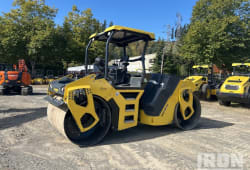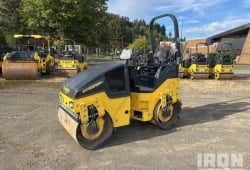The Role of Effective Preventive Maintenance Checklist for Heavy Equipment
13 Lectura mínima
)
agosto 13, 2023
In any industry that relies on heavy equipment, preventive maintenance plays a crucial role in ensuring smooth operations and minimizing downtime. Understanding the importance of preventive maintenance can save companies time, money, and resources in the long run. This article will delve into the various aspects of an effective preventive maintenance checklist for heavy equipment, including the role it plays in equipment longevity, the cost savings associated with regular maintenance, the key elements of a maintenance checklist, implementing a maintenance schedule, case studies highlighting the impact of preventive maintenance, and future trends in this field.
Understanding the Importance of Preventive Maintenance
Preventive maintenance is the practice of regularly inspecting, cleaning and maintaining equipment to prevent breakdowns and ensure optimal functioning. It is a proactive approach aimed at identifying and resolving potential issues before they escalate into larger problems.
One of the primary reasons preventive maintenance is crucial is its role in equipment longevity. By taking proactive measures to care for heavy machinery, companies can extend the lifespan of their equipment and avoid expensive replacements.
Moreover, preventive maintenance not only contributes to equipment longevity but also enhances overall operational efficiency. When equipment is well-maintained, it operates at its peak performance, resulting in increased productivity and reduced downtime. This means that businesses can maximize their output and meet customer demands without any disruptions.
Another significant benefit of preventive maintenance is its positive impact on workplace safety. Regular inspections and maintenance activities ensure that equipment is in compliance with safety regulations and is operating correctly. This reduces the risk of accidents and injuries, creating a safer working environment for employees.
Additionally, preventive maintenance leads to significant cost savings. Regularly servicing equipment prevents unexpected breakdowns and reduces costly emergency repairs. Furthermore, it allows companies to budget for maintenance expenses in advance, instead of dealing with unexpected financial burdens when equipment fails.
Furthermore, preventive maintenance plays a crucial role in maintaining product quality. For industries that rely on precise machinery to produce goods, such as the pharmaceutical or food industry, regular maintenance ensures that the equipment is functioning correctly and meets the required standards. This helps businesses avoid costly product recalls, reputation damage, and customer dissatisfaction.
Moreover, preventive maintenance fosters a culture of accountability and responsibility among employees. When employees are involved in the maintenance process, they become more aware of the importance of caring for equipment and are more likely to report any potential issues. This creates a collaborative work environment where everyone is invested in ensuring the smooth operation of the company's assets.
In conclusion, preventive maintenance is a critical practice that offers numerous benefits to businesses. From extending equipment lifespan and enhancing operational efficiency to promoting workplace safety and reducing costs, the advantages of preventive maintenance are undeniable. By implementing a proactive maintenance strategy, companies can not only avoid equipment breakdowns but also optimize their operations and stay ahead in today's competitive market.
Key Elements of a Preventive Maintenance Checklist
Implementing a comprehensive preventive maintenance checklist is essential for maintaining heavy equipment efficiently. By regularly inspecting, cleaning, lubricating, and replacing parts, you can ensure that your equipment remains in good working condition and minimize the risk of unexpected breakdowns. Below are some key elements that should be included in your preventive maintenance checklist:
Inspection of Equipment
Regular inspection ensures that all components of the equipment are in good working condition. This includes checking for wear and tear, leaks, and any potential issues that may affect the equipment's performance or safety. During an inspection, it is important to thoroughly examine each part of the equipment, including the engine, hydraulic systems, electrical components, and structural elements. By identifying and addressing any problems early on, you can prevent costly repairs and downtime.
During the inspection process, it is also crucial to keep detailed records of any findings. This allows you to track the condition of your equipment over time and identify any recurring issues that may require further attention. Additionally, maintaining accurate inspection records can be beneficial for compliance purposes, as certain industries may have specific regulations regarding equipment maintenance and safety.
Regular Cleaning and Lubrication
Cleanliness is vital for the smooth operation of heavy machinery. Regularly cleaning and lubricating equipment removes dirt, debris, and rust, preventing damage and ensuring optimal functionality. When cleaning the equipment, it is important to use appropriate cleaning agents and techniques that are safe for the specific materials and components of the machinery. This helps to avoid any potential damage or corrosion that could occur from using harsh or incompatible cleaning products.
In addition to cleaning, proper lubrication is essential for minimizing friction and wear between moving parts. Lubricants help to reduce heat, prevent corrosion, and extend the lifespan of components. It is important to follow the manufacturer's recommendations for lubrication intervals and use the appropriate type and amount of lubricant for each specific part. Regularly inspecting the lubrication points and replenishing or replacing lubricants as needed will help to ensure optimal performance and prevent premature wear.
Scheduled Parts Replacement
Proactively replacing worn-out parts prevents unexpected breakdowns and extends equipment life. This includes replacing filters, belts, hoses, and other components as specified by the manufacturer's guidelines. Keeping track of the recommended replacement intervals for each part is crucial to ensure that they are replaced promptly. Failure to replace worn-out parts can lead to decreased performance, increased fuel consumption, and potential damage to other components.
When replacing parts, it is important to use genuine manufacturer parts or high-quality aftermarket alternatives. Using substandard parts can compromise the performance and reliability of the equipment. Additionally, following the manufacturer's installation instructions and torque specifications is essential to ensure proper fit and functionality.
Regularly reviewing and updating your preventive maintenance checklist is also important. As technology evolves and equipment usage patterns change, new maintenance requirements may arise. By staying informed about industry best practices and consulting with equipment manufacturers or maintenance experts, you can continually enhance your preventive maintenance program and maximize the lifespan and performance of your heavy equipment.
Implementing a Preventive Maintenance Schedule
Creating and implementing a preventive maintenance schedule is crucial for effectively managing heavy equipment. It helps to ensure that the equipment operates at its optimal level, minimizing downtime and maximizing productivity. A well-planned maintenance schedule can also extend the lifespan of the equipment, saving the company money in the long run.
Determining the Frequency of Maintenance Tasks
When it comes to determining the frequency of maintenance tasks, there are several factors to consider. The type of equipment and its usage plays a significant role in establishing an appropriate schedule. For example, equipment that is used more frequently or in harsh environments may require more frequent maintenance compared to equipment that is used less often or in controlled conditions.
Consulting the manufacturer's recommendations is a good starting point. Manufacturers often provide guidelines on how often specific maintenance tasks should be performed. These recommendations are based on their extensive knowledge and understanding of the equipment. Additionally, industry best practices can also provide valuable insights into establishing an effective maintenance schedule.
It is important to note that the frequency of maintenance tasks may need to be adjusted over time. As the equipment ages or as its usage patterns change, the maintenance schedule may need to be modified to ensure that it remains effective. Regular evaluation and monitoring of the equipment's performance can help identify any necessary adjustments.
Assigning Responsibility for Maintenance
Assigning responsibility for maintenance tasks is a critical step in implementing a preventive maintenance schedule. It is essential to clearly define roles and responsibilities to ensure that the right tasks are assigned to the right personnel. This helps to ensure that inspections and repairs are conducted by professionals who are experienced with the specific equipment.
In some cases, it may be necessary to have dedicated maintenance personnel who are solely responsible for the upkeep of the equipment. These individuals should have the necessary training and expertise to perform the required tasks effectively. Alternatively, maintenance tasks can be assigned to existing staff members who have received the appropriate training and have demonstrated competence in handling maintenance activities.
Regular communication and collaboration between maintenance personnel and equipment operators are also crucial. Operators are often the first to notice any potential issues or abnormalities with the equipment during their day-to-day operations. Encouraging open lines of communication and providing a platform for operators to report any concerns can help prevent minor issues from escalating into major problems.
Documenting and Tracking Maintenance Activities
Proper documentation of all maintenance tasks is essential for effective preventive maintenance. It helps to track completed work and allows for easy reference in the future. Documentation can include details such as inspection dates, parts replaced, and any notes or recommendations for future maintenance.
There are various ways to document and track maintenance activities. One common method is to use a computerized maintenance management system (CMMS). A CMMS allows for the centralized management of maintenance tasks, providing a comprehensive record of all maintenance activities performed on the equipment. This system can generate reports, track equipment history, and schedule future maintenance tasks.
Another approach is to maintain a physical logbook or maintenance record for each piece of equipment. This logbook can be used to record details of each maintenance task, including the date, the person responsible, and any relevant observations or recommendations. This physical record serves as a tangible reference and can be easily accessed when needed.
Regardless of the method chosen, it is important to ensure that the documentation is accurate, up-to-date, and easily accessible. This allows for effective analysis of maintenance trends, identification of recurring issues, and informed decision-making regarding future maintenance activities.
Case Studies: The Impact of Preventive Maintenance on Heavy Equipment
Real-life examples provide concrete evidence of how preventive maintenance positively affects heavy equipment. Several notable benefits have been observed:
Reduced Equipment Downtime
Companies that implement preventive maintenance experience fewer unexpected breakdowns, resulting in reduced equipment downtime. Proactively identifying and addressing potential issues leads to more productive operations and increased efficiency.
For example, a construction company that regularly schedules preventive maintenance for its fleet of excavators has seen a significant reduction in equipment downtime. By conducting regular inspections, they can identify and address minor issues before they turn into major breakdowns. This proactive approach has allowed them to keep their equipment running smoothly, minimizing costly delays and ensuring that projects are completed on time.
In another case, a manufacturing plant that implemented a comprehensive preventive maintenance program for its heavy machinery noticed a remarkable decrease in equipment downtime. By regularly lubricating, cleaning, and inspecting their machines, they were able to prevent unexpected breakdowns and keep their production line running smoothly. This not only saved them time and money but also improved their overall productivity.
Extended Equipment Lifespan
Regular maintenance significantly extends the lifespan of heavy equipment. By caring for machinery and addressing potential issues early on, companies can avoid premature equipment replacements and maximize their return on investment.
For instance, a mining company that follows a strict preventive maintenance schedule for their mining trucks has witnessed a significant increase in the lifespan of their vehicles. By regularly replacing worn-out parts, conducting thorough inspections, and performing necessary repairs, they have been able to keep their trucks in optimal condition for a longer period. This has not only saved them the cost of purchasing new trucks but also allowed them to maximize their operational efficiency.
In another example, a shipping company that invests in preventive maintenance for their cargo cranes has seen a remarkable improvement in the lifespan of their equipment. By regularly greasing the moving parts, inspecting the structural integrity, and conducting load tests, they have been able to prevent premature wear and tear. As a result, their cranes have been able to handle heavy loads for longer periods, reducing the need for frequent replacements and ultimately saving the company a significant amount of money.
Improved Safety Measures
Preventive maintenance plays a crucial role in ensuring the safety of both operators and bystanders. Regular inspections help identify any safety hazards, reduce the risk of accidents, and maintain compliance with safety regulations.
For example, a transportation company that conducts regular preventive maintenance on its fleet of buses has noticed a significant safety improvement. By inspecting the brakes, tires, and other critical components, they can identify potential safety hazards and address them promptly. This proactive approach has helped them prevent accidents and ensure the well-being of their passengers and drivers.
In another case, a construction company that prioritizes preventive maintenance on its heavy construction equipment has experienced a notable reduction in workplace accidents. By regularly inspecting the safety features, such as seat belts, emergency stop buttons, and warning lights, they have been able to maintain compliance with safety regulations and create a safer working environment for their employees.
Future Trends in Preventive Maintenance
With advancements in technology, the field of preventive maintenance continues to evolve:
Preventive maintenance is a crucial aspect of equipment management, ensuring the longevity and reliability of heavy machinery. By implementing a well-designed maintenance plan, companies can minimize downtime, reduce repair costs, and maximize productivity. As technology continues to advance, new trends are emerging in the field of preventive maintenance, revolutionizing the way companies manage their equipment.
The Role of Technology in Maintenance
Technological tools such as computerized maintenance management systems (CMMS) and Internet of Things (IoT) devices are increasingly being adopted to streamline maintenance processes. CMMS software allows companies to effectively manage maintenance tasks, track work orders, and schedule preventive maintenance activities. With the help of IoT devices, the equipment can be connected to a network, enabling real-time monitoring and data collection. This connectivity allows for predictive maintenance, as equipment performance data can be analyzed to identify potential issues before they lead to costly breakdowns.
Furthermore, the integration of artificial intelligence (AI) and machine learning algorithms into maintenance processes is transforming the way companies approach preventive maintenance. By analyzing vast amounts of data, AI-powered systems can identify patterns and anomalies, providing valuable insights for proactive maintenance. These systems can predict equipment failures, optimize maintenance schedules, and recommend the most effective maintenance strategies, ultimately improving equipment performance and reducing downtime.
Predictive Maintenance: The Next Step?
Predictive maintenance is considered the next step in the evolution of preventive maintenance. By harnessing the power of data analytics and machine learning algorithms, companies can predict equipment failures before they occur. This proactive approach allows for timely repairs and maintenance interventions, preventing costly breakdowns and optimizing equipment performance.
The implementation of predictive maintenance involves the continuous monitoring of equipment performance, and collecting data on various parameters such as temperature, vibration, and energy consumption. This data is then analyzed using advanced algorithms to identify patterns and anomalies that indicate potential issues. By detecting early warning signs, companies can take corrective actions, such as adjusting operating conditions or scheduling maintenance activities, to prevent equipment failures and optimize maintenance efforts.
Moreover, predictive maintenance offers the opportunity for companies to transition from reactive to proactive maintenance strategies. Instead of waiting for equipment failures to occur, companies can anticipate maintenance needs and address them before they impact operations. This shift not only saves costs associated with unplanned downtime but also improves overall equipment reliability and safety.
In conclusion, an effective preventive maintenance checklist is crucial for heavy equipment. By understanding the importance of preventive maintenance and implementing key elements such as inspections, cleaning, lubrication, and scheduled parts replacement, companies can ensure the longevity of their equipment while saving costs in the long run. Establishing a preventive maintenance schedule, documenting maintenance activities, and learning from case studies showcasing the benefits of preventive maintenance further enhance equipment reliability and safety. As technology advances, the future of preventive maintenance lies in leveraging technological tools and adopting predictive maintenance practices to optimize equipment performance and minimize downtime. Embracing these future trends in preventive maintenance will enable companies to stay ahead in a competitive market and achieve operational excellence.

Mike Kennedy is Boom & Bucket's Marketplace Operations Manager, where he leads shipping, warranties, and post-sale operations to create a seamless buyer experience. As one of the company's earliest team members, Mike helped build the foundation of Boom & Bucket's operations and guided its growth through acquisition by RB Global. He is passionate about scaling marketplaces, solving operational challenges, and improving efficiency to deliver industry-leading results.














